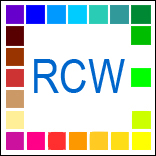|
On a 3 color wheel there is 1 set of triads.
On a 6 color wheel there are 2 sets of different triads and 6 sets of different analogous colors (that's one set on each side of each color = 6 sets).
On a 12 color wheel there are 4 different sets of triads and 12 sets of analogous colors (that's a set on each side of each color = 12 sets).
On a 36 color wheel there are 12 different sets of triads and 36 sets of analogous colors (that's a set on each side of each color = 36 sets).
On a 36 color wheel there are 11 sets of split complements possible for each color. 11 x 36 = 394 split complement sets for the designer to work with.
Here is the example for 36RCW#1yellow; #1 to its split complements #18 & #20, that's one color on each side next to the opposite color #19blue.
Another would be two colors over from the opposite color, #1 to #17 and #21.
Another would be three colors over from the opposite color, #1 to #16 & #22.
All the way up to eleven colors away and they don't have to be full chroma colors, they can be tints or shades of the full chroma colors. Twelve colors away from the opposite color on a 36 color wheel would be a triadic color scheme. Using colors that are not opposite or split-opposite, colors within 130º of each other (13 colors on the 36 RCW) are considered to be Analogous colors. Green, yellow and red are analogous on a six color wheel, just like yellow-green, yellow and orange are analogous on a twelve color wheel.
Split complementary colors can be inclusive containing analogous colors next to each main color. Analogous colors are just inclusive. What makes the color schemes is the use of two colors an equal distance away from the opposition color or colors next to each other or the combination of both.
Designer colors are the combinations of these colors within the scheme.
Other geometric forms can also be used, like the tetrad square, but a square is limiting forcing four exact colors. Two split complement sets will give you the same results and be veritable at the same time. Consider other than using the triadic scheme only an exercise in color.
 IP Logged IP Logged
|

 Home
Home

 Help
Help

 Search
Search

 Login
Login

 Register
Register

 Broadcast Message to Admin(s)
Broadcast Message to Admin(s)

 « Home
« Home  ‹ Board
‹ Board  Top of this page
Top of this page 
 Pages: 1
Pages: 1

